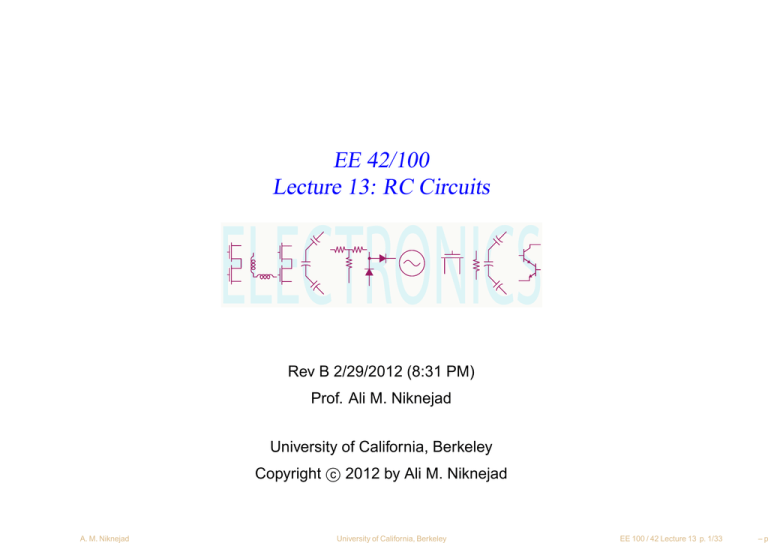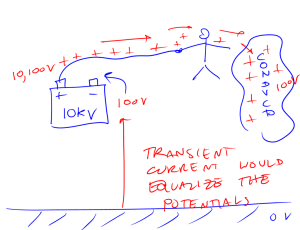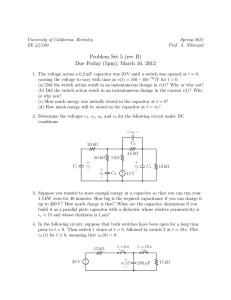ELECTRONICS EE 42/100 Lecture 13: RC Circuits
advertisement

EE 42/100 Lecture 13: RC Circuits ELECTRONICS Rev B 2/29/2012 (8:31 PM) Prof. Ali M. Niknejad University of California, Berkeley c 2012 by Ali M. Niknejad Copyright A. M. Niknejad University of California, Berkeley EE 100 / 42 Lecture 13 p. 1/33 –p RC Circuits • Many circuits can be modeled as a combination of resistors and capacitors. A good example is the gates inside of a microprocessor. To determine how fast these gates “switch” (in other words how fast we can run a computer), we can model the entire system by an RC circuit. • The general solution of RC circuits is a powerful tool that we can apply to a great range of problems and so it deserves some special attention. A. M. Niknejad University of California, Berkeley EE 100 / 42 Lecture 13 p. 2/33 –p Example: Circuit Charging • Suppose a battery is connected to a switch and an RC circuit as shown. Initially we assume the capacitor is uncharged (v(0) = 0) and the switched is closed at time t = 0. What happens next? A. M. Niknejad University of California, Berkeley EE 100 / 42 Lecture 13 p. 3/33 –p Intuitive Guess at Solution • We might guess that current would begin to flow into the capacitor, where at time zero at least, Vs i(0) = R • But as time goes on, the current will change, because as charge accumulates on the capacitor plates, its voltage rises and so the current through R reduces i(t) = • Vs − v(t) R Note that if v(t) reaches Vs , then the current would drop to zero, which means that v(t) would then stop changing as well. This is an interesting state because if we put the system in such a state, then dv/dt = 0 and so the system just stays there. A. M. Niknejad University of California, Berkeley EE 100 / 42 Lecture 13 p. 4/33 –p Setting up Equations • While we can surmise many properties of this circuit by using intuition, to find the exact solution requires us to setup KCL/KVL equations just as before, but now we must solve differential equations. A. M. Niknejad University of California, Berkeley EE 100 / 42 Lecture 13 p. 5/33 –p Linear Differential Equations • While solving differential equations is a lot harder, we can surmise many things about the solution without actually solving any equations. • For a circuit with a single capacitor and any number of resistors, if the capacitors and resistors are all linear, then the resulting equations will be a linear and first-order. • The order of the equations is determined by the highest derivative term. Since for capacitors the current is proportional to dv/dt, we end up with a system of first-order ordinary differential equations. They’re “ordinary” in that they involve normal derivatives, instead of “partial” derivatives. A. M. Niknejad University of California, Berkeley EE 100 / 42 Lecture 13 p. 6/33 –p Linearity and Superposition • The first important property of linear equations is that superposition applies. Superposition means that if the circuit is excited with many inputs simultaneously, the resulting solution is the same as the summation of all the solutions to the individual stimuli applies one at a time. • This is very handy, even if there is only one stimulus! That’s because a complicated stimulus can often be broken down into simpler functions (e.g. a Fourier Series). • For example, the solution for the stimulus for vs = V0 sin(ωt) can be determined by solving the system for vs = V0 ejωt . • That’s because ejx − e−jx sin(x) = 2j A. M. Niknejad University of California, Berkeley EE 100 / 42 Lecture 13 p. 7/33 –p Time Invariance • Another very important property is the concept of time invariance. If a circuit stays the same, then no matter when you apply an input, the output should look the same. • In other words, if you build an RC circuit today and excite a voltage source, you’d expect to see the same response if you did the same experiment 10 minutes later (assuming no aging of components), assuming you shift your time reference. • More compactly, if shift the stimulus to another time, vs′ = vs (t − T ), then the solution v ′ (t) = v(t − T ) (we simply shift the time reference). A. M. Niknejad University of California, Berkeley EE 100 / 42 Lecture 13 p. 8/33 –p Homogeneous Solution • When there are no sources present, then the solution of a differential equations is called the “homogeneous” solution. That’s a fancy name for the “zero input” solution. • Why is there a solution for zero input? A system described by a differential equation is not a simple memory-less input-output relation, so even if there are no explicit inputs, there can be an output! • The output waveform is a function of the state of the system, which in this case is the capacitor voltage. If the capacitor voltage is initially charged, then there’s going to be an output, despite there being no input. A. M. Niknejad University of California, Berkeley EE 100 / 42 Lecture 13 p. 9/33 –p Steady-State Homogenous Solution • If there are no inputs and we wait long enough, we can say that eventually the system will come to rest. When the system comes to rest, the voltages/currents do not change, and so dv/dt = 0 for every capacitor. From this we can find the steady-state value of the homogenous solution. • We can find this solution directly if we note that dv/dt = 0 implies the current through all the capacitors is zero, or it’s replaced with an open circuits. A. M. Niknejad University of California, Berkeley EE 100 / 42 Lecture 13 p. 10/33 – Forced Solution • Because of linearity, we see that any time we do apply an input to the system, the response will be a super-position of the response to “no input” and the response to the stimulus, or the forced solution. In other words, “zero input” is also an important input to consider when dealing with differential equations. • The response of the circuit to the stimulus is a function of the stimulus and the circuit. The homogeneous response is just a function of the circuit itself, and so it’s also called the characteristic solution. A. M. Niknejad University of California, Berkeley EE 100 / 42 Lecture 13 p. 11/33 – Transient Waveforms • When we solve a circuit with a time-varying input, we say that it’s the transient solution, as opposed to the “DC” solution, which is the solution when only DC voltages are applies. • Recall that DC voltages mean DC for all of time, including the past, which means that the circuit was “turned on” at time −∞, or equivalently it has always been on. • Therefore if we “turn on” the circuit at some particular time, the solution is not the DC solution but the transient solution. A. M. Niknejad University of California, Berkeley EE 100 / 42 Lecture 13 p. 12/33 – Transients • If we “turn on” the circuit at a particular time but only apply a steady source, we would expect that the circuit should eventually converge to the DC solution. This is true for stable circuits. Circuits with positive resistors and capacitors are stable. There are counter examples, such as a DC current source switched onto a capacitor but for most examples, the steady-state solution is a static solution. • In other words, if we wait long enough, the time-varying waveforms should die out and the final solution should converge to the DC solution. • This is called the “steady-state” solution, or the solution when all the transients have died out. We therefore say that the waveforms at the “turn on” time are transients that die out. A. M. Niknejad University of California, Berkeley EE 100 / 42 Lecture 13 p. 13/33 – Solution Procedure • It seems like we’ve rambled on without getting any closer to an actual solution. But the truth is that we’re now in a much better position to solve our original problem. • We should always start by finding the homogenous (“zero-input”) solution. For linear differential equations, this is relatively simple. From the theory of differential equations, we know that the an n’th order system has n linearly independent solutions. • Once we find these n solutions (often by guessing), we use “initial conditions” to find the particular form of the homogenous solution. • Miraculously, for linear equations, to find the homogeneous solutions we just have to plug A0 eat into the equation and solve for a. A0 is found from the initial conditions, v(0), v ′ (0), etc. If there is only one solution (first order equation), you only need the initial voltage or “state” of the system. A. M. Niknejad University of California, Berkeley EE 100 / 42 Lecture 13 p. 14/33 – Forced Solution • Finding the forced solution is harder. There’s a procedure for linear systems that involves finding the “impulse” response of the system. For now we will just find the particular solution by some guesswork. • For instance, if the stimulus is a DC input, note that a DC output is also a solution to the differential equation. From uniqueness, we know that if we find a solution, it’s the solution! A. M. Niknejad University of California, Berkeley EE 100 / 42 Lecture 13 p. 15/33 – Back to Example... A. M. Niknejad University of California, Berkeley EE 100 / 42 Lecture 13 p. 16/33 – RC Time Constant • The term τ = RC is an extremely important parameter. Very creatively, it’s known as the circuit’s RC time constant (we’re a very creative bunch). • This is the characteristic time of the circuit (not stimulus), and it tells you how long the transient homogenous solution will last. Within a few time constants, the transient solution is all but gone. In theory it takes forever for it to completely disappear, but soon it’s so small that it’s not worth thinking about. A. M. Niknejad University of California, Berkeley EE 100 / 42 Lecture 13 p. 17/33 – Complete Solution • With all the various components in place, we can finally write the complete solution. A. M. Niknejad University of California, Berkeley EE 100 / 42 Lecture 13 p. 18/33 – Current Through Capacitor • Recall that i = Cdv/dt, which allows us to find the transient current waveform. A. M. Niknejad University of California, Berkeley EE 100 / 42 Lecture 13 p. 19/33 – Capacitor Discharge • Now suppose an initially charged capacitor is discharged to ground through a switch. We can solve this problem quickly based on what we have learned. A. M. Niknejad University of California, Berkeley EE 100 / 42 Lecture 13 p. 20/33 – Capacitor as a “Battery” • Note that a very large capacitor acts like a battery. Unfortunately, as we draw current from the battery, it’s output voltage will drop. But if it’s sufficiently large, the rate of discharge will be slow. • Suppose you model a linear load as a resistor (Thevenin again) that draws 100mA from a 1V supply, or RL = 10Ω. • Then if we connect a practical (large) capacitor of C = 100 µF, current would flow for approximately RC seconds while the voltage is larger than 0.6 V. RC = 10Ω · 100 µF = 1000 µs = 1 ms • That’s only 1/1000’th of a second! A. M. Niknejad University of California, Berkeley EE 100 / 42 Lecture 13 p. 21/33 – Step Response • A unit step function is described by u(t) = ( 0 1 t<0 t≥1 • While the waveform has an artificial “jump” (difficult to reproduce in real life), it’s a very useful model for real stimuli. It’s like a source that turns “on” at time t = 0. • The solution procedure is therefore very similar to the example with the switches. A. M. Niknejad University of California, Berkeley EE 100 / 42 Lecture 13 p. 22/33 – Step Response of Circuit • The step response of a circuit is extremely useful. Not only does it have engineering significant of it’s own, but in a miraculous way it contains everything you need to know about a system! In other words, if you know the step response, you know the response of the circuit to any input! • You can imagine that any input can be approximated by a series of small steps and then use superposition. But that’s for another class... A. M. Niknejad University of California, Berkeley EE 100 / 42 Lecture 13 p. 23/33 – Pulse Response • Now suppose that we apply a pulse to our circuit. We can mathematically construct a pulse as p(t) = u(t) − u(t − T ) • which is the sum of a unit step and a negative unit step applied at a later time T . We can now invoke superposition and say the solution is the same as the sum of the solutions for each step applied individually. A. M. Niknejad University of California, Berkeley EE 100 / 42 Lecture 13 p. 24/33 – Pulse Reponse (cont) • The solution for the second step is easy to do since it’s just a sign inversion (absorbed into constants) and a delay. By time invariance, we actually know the solution already. The circuit does not care “when” we apply the step function, because the circuit itself is not changing. A. M. Niknejad University of California, Berkeley EE 100 / 42 Lecture 13 p. 25/33 – Complete Pulse Response • Simply sum the step responses and be sure to delay the output. A. M. Niknejad University of California, Berkeley EE 100 / 42 Lecture 13 p. 26/33 – Filtering: Short Pulse Response • Imagine a very narrow pulse is applied to the circuit, such that T ≪ RC. In this case, the output is almost nil. In other words, the RC circuit will not respond to a very short “fast” stimulus. It acts like a filter. A. M. Niknejad University of California, Berkeley EE 100 / 42 Lecture 13 p. 27/33 – DC Blocking Capacitor • It’s very common to connect two circuits using a “blocking” or “coupling” capacitor, as shown. • The reason is that we often wish to pass signals from one block to another (say one amplifier to another), but we want to bias the stages differently (apply different DC levels). We desire a circuit that can pass AC signals but block DC signals. A. M. Niknejad University of California, Berkeley EE 100 / 42 Lecture 13 p. 28/33 – DC Block (cont) • Let’s calculate the voltage across the load as shown. We know that the steady-state solution is zero because when the capacitor goes to an open circuit, the load is shunted to ground. But if the source changes, then the output will move. • Roughly speaking, if the circuit changes faster than the RC time scale, the output will always be moving to respond to the input. But if it changes more slowly, the capacitor will “block” the signal. • That’s because in steady state the capacitor charges up the voltage of the source and so the voltage of the resistor is vR (t) = vs − vc (t) A. M. Niknejad University of California, Berkeley EE 100 / 42 Lecture 13 p. 29/33 – A Differentiator • Suppose we use an op-amp to create a virtual ground as shown. Then the output voltage, which is simply given by the capacitor current multiplied by R, is given by vo (t) = −iR = −RC • dvs dt The circuit calculates the derivative of the input voltage A. M. Niknejad University of California, Berkeley EE 100 / 42 Lecture 13 p. 30/33 – An Integrator • If we swap the location of the capacitor and the resistor, it performs an integration operation. • To see this, note that the output voltage is simply the voltage on the capacitor, which is given by the net charge flowing into it from the source v(t) = −Vc dVc dvo Vs =C = −C R dt dt Z τ =t −1 v(t) = v(0) + vs (τ )dτ RC τ =0 • Note: τ is a “dummy” variably of integration. A. M. Niknejad University of California, Berkeley EE 100 / 42 Lecture 13 p. 31/33 – More Complicated Example • When we setup the equations, we see that the time constant is given by the product of C and the equivalent resistance seen by C. • This can be understood if we find the Thevenin equivalent of the circuit for the homogenous solution. If we look out from the capacitors, we just see Rth . A. M. Niknejad University of California, Berkeley EE 100 / 42 Lecture 13 p. 32/33 – More Capacitors • If there are more capacitors in the circuit, we get a system of differential equations which can be solved using matrix techniques. • For this class we will not cover the more complicated solution although we can comment on the general solution. • The system of equations can be “diagonalized” by matrix factorization. The eigenvalues thus determine the time constants of the various states of the system. The independent states are determined by linear combinations of the capacitor charges, which are found from the eigenvectors. • To find the general output, therefore, we have to take the sum over all the characteristic solutions, which all have different time constants. The solution will therefore be a sum of exponential solutions. A. M. Niknejad University of California, Berkeley EE 100 / 42 Lecture 13 p. 33/33 –






![Sample_hold[1]](http://s2.studylib.net/store/data/005360237_1-66a09447be9ffd6ace4f3f67c2fef5c7-300x300.png)